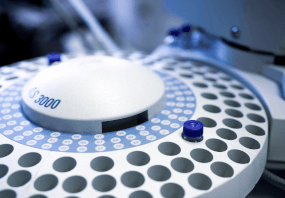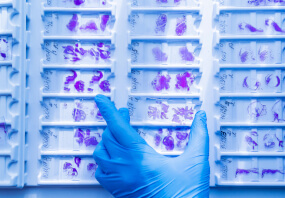General description
Transferrin receptor protein 1 (UniProt: P02786; also known as TR, TfR, TfR1, Trfr, T9, p90, CD71) is encoded by the TFRC gene (Gene ID: 7037) in human. Tfr is a disulfide-bonded homodimeric type II transmembrane glycoprotein that is involved in iron uptake. TfR is more abundantly expressed in rapidly dividing cells. Higher expression levels of TfR are seen in the placental trophoblast and hemoglobin-synthesizing reticulocytes, but expression is lost in mature erythrocytes. Cellular uptake of iron occurs via receptor-mediated endocytosis of ligand-occupied transferrin receptor into specialized endosomes. Endosomal acidification leads to iron release. Both TfR and TfR2 bind diferric transferrin better than apo-transferrin at neutral pH. However, TFR2 displays about 25-fold lower affinity for transferrin compared to TfR. TfR levels are regulated by cellular iron levels through binding of the iron regulatory proteins, IRP1 and IRP2, to iron-responsive elements in the 3′-UTR. Up-regulated upon mitogenic stimulation. TfR can be N- and O-glycosylated, phosphorylated and palmitoylated, however, the serum form is only glycosylated. TfR can be proteolytically cleaved on Arg100 to produce the soluble serum form (sTfR). Mutations in TFRC gene result in immunodeficiency 46, an autosomal recessive disorder that is characterized by early-onset chronic diarrhea, recurrent infections, hypo- or agammaglobulinemia, intermittent neutropenia, and thrombocytopenia.
Specificity
Clone 3B82A1 specifically detects transferrin receptor protein 1. It targets an epitope in the extracellullar domain.
Immunogen
Epitope: extracellular domain
His-tagged recombinant ectodomain of human Transferrin receptor protein 1.
Application
Detects Transferrin receptor protein 1 using this mouse monoclonal Anti-TfR1, clone 3B82A1, Cat. No. MABS1982 and has been tested for use in Flow Cytometry, Immunocytochemistry, Immunoprecipitation, and Western Blotting.
Research Category
Signaling
Western Blotting Analysis: A representative lot detected TfR1 in Western Blotting applications (Chloupkova, M., et. al. (2010). Blood Cells Mol Dis. 44(1):28-33; Johnson, M.B., et. al. (2004). Blood. 104(13):4287-93; Chen, J., et. al. (2015). J Biol Chem. 290(12):7841-50; Vogt, T.M., et. al. (2003). Blood. 101(5):2008-14).
Immunocytochemistry Analysis: A representative lot detected TfR1 in Immunocytochemistry applications (Johnson, M.B., et. al. (2007). Mol Cell Biol. 18(3):743-54; Vogt, T.M., et. al. (2003). Blood. 101(5):2008-14).
Immunoprecipitation Analysis: A representative lot detected TfR1 in Immunoprecipitation applications (Johnson, M.B., et. al. (2004). Blood. 104(13):4287-93; Vogt, T.M., et. al. (2003). Blood. 101(5):2008-14).
Quality
Evaluated by Flow Cytometry in K562 cells.
Flow Cytometry Analysis: 1 µg of this antibody detected TfR1 in 1X10E6 K562 cells.
Target description
84.87 kDa calculated.
Physical form
Format: Purified
Protein G purified
Purified mouse monoclonal antibody IgG1 in buffer containing 0.1 M Tris-Glycine (pH 7.4), 150 mM NaCl with 0.05% sodium azide.
Storage and Stability
Stable for 1 year at 2-8°C from date of receipt.
Other Notes
Concentration: Please refer to lot specific datasheet.
Disclaimer
Unless otherwise stated in our catalog or other company documentation accompanying the product(s), our products are intended for research use only and are not to be used for any other purpose, which includes but is not limited to, unauthorized commercial uses, in vitro diagnostic uses, ex vivo or in vivo therapeutic uses or any type of consumption or application to humans or animals.
- UPC:
- 51131822
- Condition:
- New
- Availability:
- 3-5 Days
- Weight:
- 1.00 Ounces
- HazmatClass:
- No
- MPN:
- MABS1982












